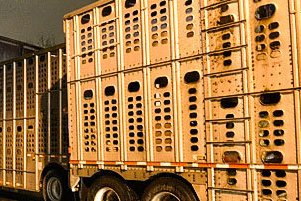In 2004, I wrote a newspaper article about the treatment of sick and diseased farm animals headed for the slaughterhouse. There were two events that brought this issue into focus for me at that time.
The first was legislation that closed small abattoirs in Canada and brought all livestock slaughter into large operations and under government regulation.
The second event was the two slaughtered Canadian cows infected with Mad Cow disease which caused an international incident between Canada and the U.S.
The inhumane treatment of farm animals in transportation was suddenly highlighted when it was found that both of the diseased cows were what the industry refers to as ‘downers’. These are animals that are too sick to board the trucks under their own steam, and are chained or roped, and dragged aboard.
The sick cattle never should have been on the transport trucks to begin with, but big business tends to ignore these pesky constraints where there is a buck to be made.
Canadian beef was banned in the U.S. when the discovery of mad cow disease in the U.S. food supply was traced back to the two diseased Canadian cows.
Animal rights groups, which have lobbied for years for more humane legislation governing the transport and slaughter of farm animals, were outraged. The beef consuming public and the economy were at risk. The Canadian government agreed it was time to ‘look into it’.
Well, fast forward to 2012 – eight years later. The Canadian government is still, apparently, ‘looking into it.’

















